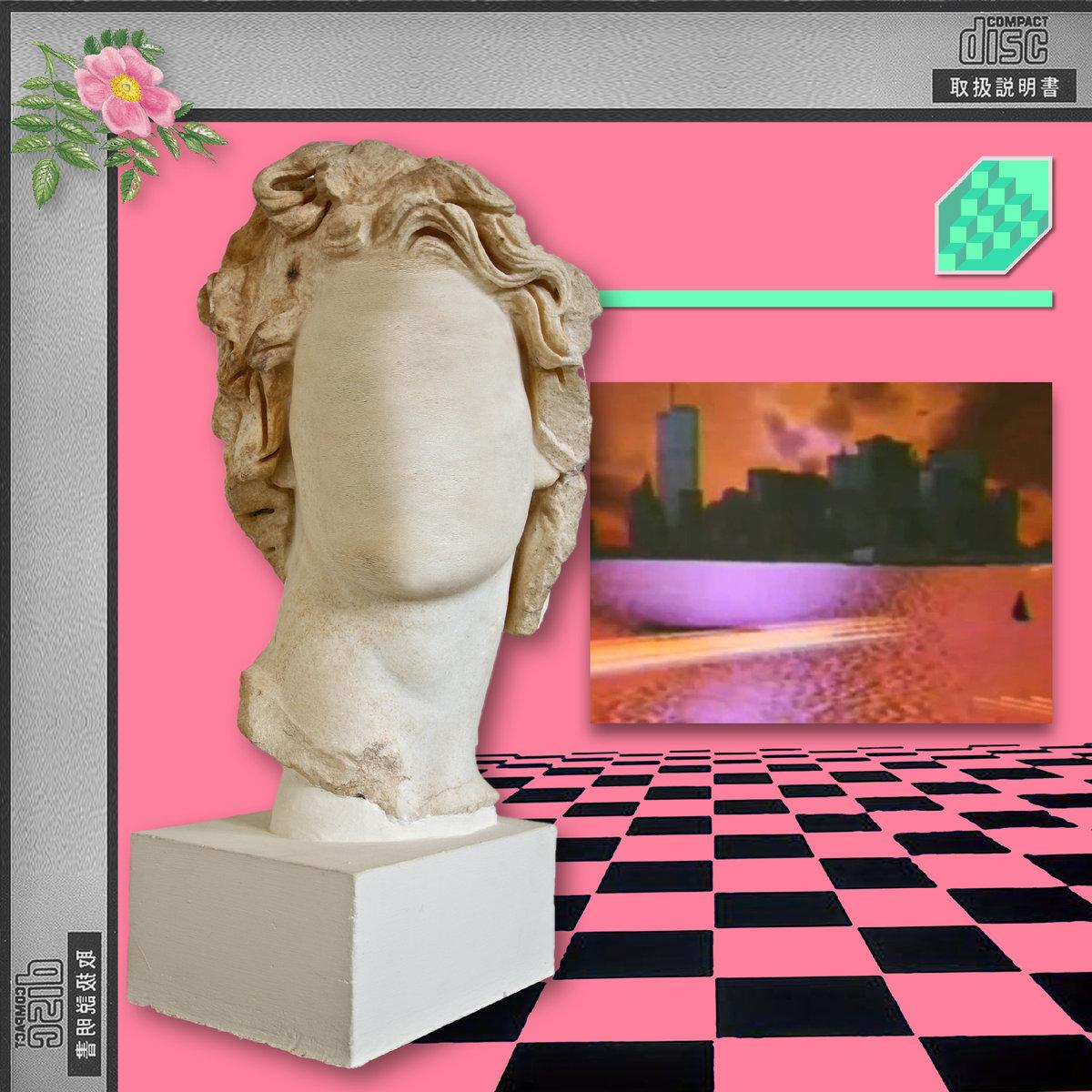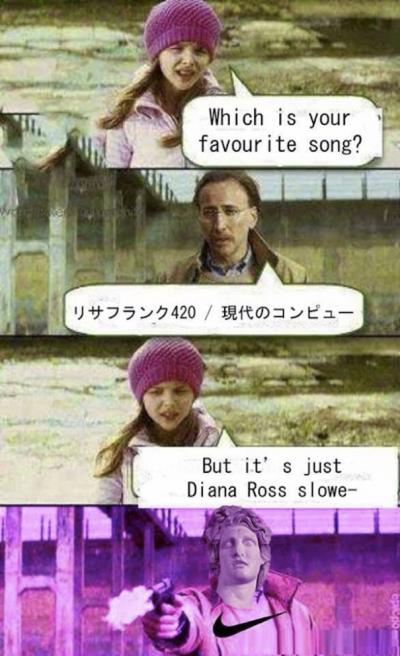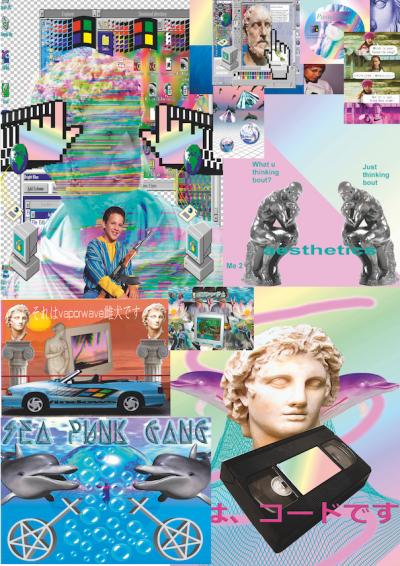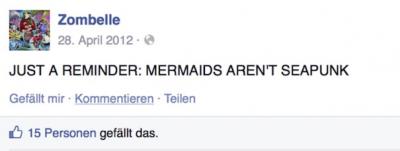The Internet genres vaporwave and seapunk mix slowed-down 1990s smooth jazz with house music, and cannot live without images of dolphins, palm trees and Greek marble statues. FrankJavCee offers a round up. He came to our attention through his video tutorials on both genres – and others like cloud rap, farm and bass, ocean grunge, witch house and slime punk. An article from the Norient book Seismographic Sounds (see and order here).
«I’m expressing myself, mom!»
(Ambassador Funk via SoundCloud)
The Internet spreads ideas like wild fire. It creates confusion and a lot of white noise. Micro-genres and their aesthetics rise quickly and fall before having time to fully develop.
Vaporwave flashed out of nowhere around the early 2010s as possibly the first new music genre of this decade. It plays with nostalgia, and it calms you down from reality: by slowing down muzak and smooth jazz, background music we all know too well from shopping malls and hotel lobbies. Ramona Andra Xavier, aka Vektroid, defined the genre’s sound when she slowed down the Diana Ross ballad «It’s Your Move» on her Floral Shoppe album. A storm of comments, criticism and tribute remixes followed her track that she had produced under her second pseudonym, Macintosh Plus. Seapunk spread on the Internet around the same time. It mixes sounds from the ocean – from water bubbles to dolphin sounds – with 1990s R&B and house, southern trap, chip tune and other contemporary music styles. The seapunk community grew fast, but was soon to disappear like sea foam – because mainstream took over, as we are going to see.
Dolphins, Greek Statues and Neptune
Both genres worship the exotic. In vaporwave you see early 1990s PowerPoint clip art mixed with Greek marble statues of various gods and goddesses. Microsoft Paint and Windows 98 or 95 aesthetics are key in vaporwave art – depending on whatever year the creators first experienced technology. Seapunk incorporates colors and topics of the ocean. 3D Nintendo64-style dolphins swim through Windows 95 desktop screens, all set in the Lisa Frank-esque neon colors that U.S. girls know from their schoolbags and books, manufactured especially for them by Lisa Frank Incorporated.
But let’s be honest. Defining and labeling these net-based micro-genres is difficult. Their aesthetics are spreading virally from person to person, replicated and mutated without any money transferred via online platforms like Tumblr, but also YouTube, Twitter, SoundCloud or Facebook. Everything grows quickly and organically, creating homages, satirical comments, and new subgenres. I suggest using the term «meme» – and not «cultures» – when trying to describe these short-lived Internet hypes. «Aesthetic» became the key term in the memes of seapunk and vaporwave. Aesthetic means artistic beauty, or, one’s personal beauty.
Irony and satire are king. Vaporwave is a term often used for software that fails to reach a market. The absurdities and impossibilities of this genre’s aesthetic are – to me – again: satire! Plastic palm trees and distorted beaches are not everyday sights to these artists (in front of their screens). Like addicts search for drugs, they google these exotic images. Manipulating them into digital landscapes they feel alive – probably expressing subconscious emotions, fears, fantasies and dreams. (Vaporwave is dreamlike and satirical while its subgenre ocean grunge is an angst driven reflection of inner frustrations and sorrows.) Seapunk images mix Japanese anime girls with large breasts and blue hair with images of the sea and computers. It is again partly ironic: computers should not become wet.
From Internet to Mainstream to Downfall
Through the Internet, these micro-genres are shared and replicated internationally, and translated into various languages around the world, from Mexico to Russia and Singapore, from Canada to Brazil. Producers and fans create a sense of identity, unity and belonging. The Bandcamp-based online label Dream Catalogue started selling digital downloads and cassettes, celebrating the rarity of these albums. Again, it is parody: manipulating music from 1980s or 1990s capitalism and selling it on old formats like tape.
And then vaporwave and seapunk zeitgeist started influencing mainstream culture. U.S. rapper Azealia Banks became a contemporary mermaid in her video clip «Atlantis». Seapunk’s founding artist Zombelle responded quickly on Facebook: «Mermaids aren’t seapunk.»
Then singer Rihanna used seapunk aesthetics in the performance of her hit song «Diamond» on Saturday Night Live on the U.S. NBC station, in front of the eyes of millions. Actually, this might have been the first recorded moment in which a black artist appropriated «memes» of predominantly white artists’ creation – thus mirroring the white rock-and-roll musicians taking riffs from black jazz musicians in the 1950s. That’s what I call irony! The moment McDonald’s starts playing slowed-down muzak and smooth jazz, vaporwave will have come full circle.
When these aesthetics grow and become mainstream these micro-genres fade away. Once they are dissected, placed in new contexts and torn apart, they become simplified, lack substance and lose their magic. In YouTube video tutorials you learn that to create vaporwave music is very simple: all you have to do is slow down a 1990s R&B track by half. Then press play.
Some Vaporwave and Seapunk Artists and Tracks



